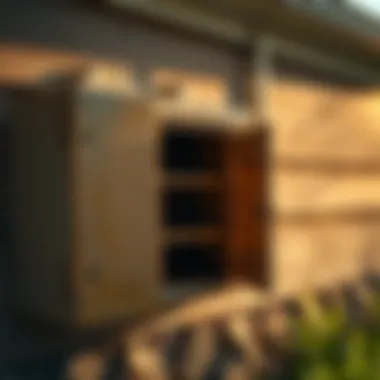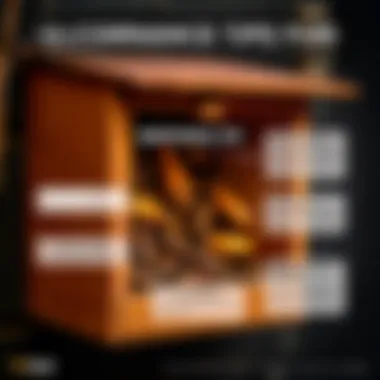Understanding the Termite Box: A Comprehensive Guide


Intro
In the realm of homeownership, the tranquility of a well-maintained residence can be easily compromised by the presence of pests. Among these, termites stand out as particularly relentless foes, capable of causing untold damage to wooden structures. This is where the concept of a termite box comes into play. A termite box serves not only as a physical barrier but also as a part of a comprehensive strategy aimed at preventing and managing infestations. Understanding how these boxes operate can arm homeowners with knowledge to safeguard their sanctuaries effectively.
Pest Identification
Detailed descriptions of common pests
Termites are not your average household pest. These voracious insects thrive in warm, humid climates and are mostly found in decaying wood or soil. There are several species of termites, but the most common ones include:
- Eastern Subterranean Termite: Found predominantly in the eastern United States, this type tunnels through the soil and can cause extensive structural damage.
- Western Subterranean Termite: Similar to the Eastern counterpart, they tend to be more aggressive in their feeding habits and are often found in the western regions.
- Drywood Termite: Preferring dry, sound wood, these termites live within the wood they consume, making them harder to detect until significant damage has occurred.
Signs and symptoms of infestations
Recognizing the early signs of a termite problem is crucial for effective control. Be on the lookout for:
- Mud tubes: Often resembling pencil-sized tunnels, these can be found along foundations or walls.
- Wings: Seeing discarded wings around windows or doors can indicate reproductive swarms.
- Hollow-sounding wood: Tapping on wood surfaces may yield a hollow sound if termites are consuming it from the inside.
Prelude to the Termite Box
Termites can be a homeowner's nightmare, silently causing damage that can lead to hefty repair bills. Thus, understanding how to combat these pests becomes imperative. This is where the concept of a termite box enters the picture, acting as both a deterrent and a monitoring tool against termite infestations. In this section, we will examine what a termite box is, how it functions, and why it’s an essential component for those looking to protect their homes from these destructive insects.
What is a Termite Box?
A termite box is a specialized device designed primarily for the detection, monitoring, and control of termite infestations. These boxes are typically placed around the perimeter of structures prone to termite activity, facilitating early intervention. They can be filled with specific baits or monitoring agents that attract termites, thus helping homeowners and pest control professionals gauge whether termites are present in their vicinity.
Consider it a dog on the prowl, sniffing out trouble where it lurks. The timely identification of these pests is crucial, as the earlier they are detected, the easier and less expensive it is to manage the damage they can cause.
Purpose and Functionality
The purpose of a termite box goes beyond mere detection; it plays a multi-faceted role in termite management. Here are some benefits:
- Early Detection: By regularly checking the boxes, homeowners can detect termite presence before they start nibbling away at the wooden frameworks of their homes.
- Baiting Systems: Many types of termite boxes can be filled with bait, effectively drawing termites in to consume the bait rather than your home’s structure. This method is commonly seen in bait stations, allowing for targeted treatment while minimizing the use of chemicals.
- Monitoring and Maintenance: A termite box serves as a long-term monitoring solution. Regular inspections of these boxes can provide insights into levels of termite activity and help guide pest management strategies. If a box shows signs of termite interaction, it’s a clear sign that a more comprehensive treatment may be necessary.
"Investing in a termite box is like buying insurance—better to have it and not need it than to need it and not have it."
The presence of these boxes allows homeowners to keep a watchful eye on their properties without needing to rely entirely on pest control services. In essence, they empower homeowners to take an active role in pest management. Through understanding the termite box, its purpose, and functionality, individuals can be better equipped to make informed decisions about protecting their homes.
Types of Termite Boxes
Understanding the various types of termite boxes is crucial for homeowners looking to safeguard their properties from these destructive pests. These boxes serve as essential components of pest management, each offering unique benefits and strategies for combating termite infestations. By knowing these differences, you can make informed decisions and enhance your overall pest control approach.
Bait Stations
Bait stations are a popular choice among homeowners, designed to attract termites and ultimately eliminate them. These systems use a slow-acting insecticide housed within a bait that termites find irresistible. Once they consume the bait, they return to their colony, where the poison spreads, leading to the decline of the entire population.
One key advantage of bait stations is their preventive nature. They don't just react to an existing infestation; they proactively protect your home by monitoring and controlling termite activity continuously.
- Advantages of Bait Stations:
- Low Environmental Impact: Less harmful to non-target species.
- Regular Monitoring: Offers insight into termite activity levels.
- Less Chemical Use: Focuses on a targeted approach rather than widespread treatments.
However, proper installation is essential. Bait stations must be strategically placed around the perimeter of your home, often at intervals of around ten to twenty feet, depending on the level of risk. Regular inspections and timely replenishment of bait are also necessary to maintain effectiveness.
Monitoring Stations
Monitoring stations serve primarily as early warning systems. Unlike bait stations, they do not contain pesticides. Instead, these boxes attract termites, allowing homeowners to assess the level of activity in the area. The presence of termites in monitoring stations can alert you to the need for further action, whether that involves adding bait stations or pursuing other termite control methods.
The concept behind monitoring stations is simple but effective. By regularly checking these stations, you can stay ahead of potential infestations before they escalate into serious problems.
Some aspects to consider with monitoring stations include:


- Routine Checks: Regular inspections are vital to gauge termite presence.
- Integration with Other Methods: Best utilized in tandem with bait or chemical treatments for comprehensive prevention.
Chemical Treatments
Chemical treatments involve applying pesticides directly to the soil or structural elements of a home to create a barrier against termites. These treatments can be classified into two main categories: soil treatments and wood treatments. Soil treatments are typically used during the construction phase, while wood treatments are generally employed for existing structures.
Using chemical treatments can provide immediate protection, making them appealing to those facing an urgent infestation. The advantages of chemical treatments include:
- Broad Application: Effective against various types of termites, including subterranean and drywood species.
- Long-lasting Effects: Some treatments can last for years, offering durable protection.
However, there are important considerations. Chemical treatments can pose risks to the environment and non-target species. Homeowners should ensure that any application complies with local regulations and should consult certified professionals for application.
It's essential to remember that a combination of methods often yields the best results. By understanding the distinctions and applications of these termit management tools, you can tailor a strategy that fits your specific needs and ensures your home remains termite-proof.
Design and Construction
Materials Used in Termite Boxes
When looking into termite boxes, the materials that compose them play a crucial role in their effectiveness and durability. A termite box must be built from materials that resist degradation while also allowing for specific interactions with the pests. Commonly, these boxes are made from durable plastics, which can withstand various weather conditions. This is key for homeowners, as a sturdy box ensures reliable pest management throughout the year.
Some termite bait stations also incorporate stainless steel components, especially in monitoring stations, to fend off moisture and rust. Using treated wood, while occasionally employed, has its limitations, as it can be subject to rot over time, jeopardizing the physical integrity of the structure. Though it may seem counterintuitive to make a box to trap pests with materials some insects might seek out, the reality is that a careful selection of materials ensures long-lasting functionality.
Here’s a summary of common materials:
- Plastic: Offers durability and weather resistance.
- Metal: Provides strength, often used in monitoring stations.
- Specific Treatments: Added to woods to improve resistance to pests and decay.
These materials not only enhance protection against termites but can also make maintenance easier. Besides, using the right materials can help the environment by reducing the need for harmful chemicals.
Structural Integrity Considerations
The design of termite boxes is not just about selecting the right materials; it’s also about ensuring a strong structural integrity. If these boxes lack proper construction, they can easily become compromised, leading to ineffective termite control or, worse, an exacerbation of the problem. A well-constructed termite box should adhere to specific guidelines that ensure it can function as intended under various conditions.
Think about it like this – if the box isn’t secure, it becomes a mere shell rather than a fortress against pests. Factors that need to be considered include the following:
- Design Shape: A robust design can mitigate any collapsing or bending, while asymmetric designs might lead to uneven distribution of bait or issues with moisture control.
- Sealing Mechanisms: Proper seals ensure that termites cannot escape once they enter, increasing the efficacy of the bait.
- Placement Specifications: Ensuring the box is placed in a true flat position stops it from bending or leaning, which may lead to unintended structural strain.
To sum it up, the meticulous design and construction of termite boxes can significantly enhance their effectiveness. By focusing on the right materials and ensuring structural integrity, homeowners not only protect their property more effectively but also potentially save on costly repairs in the long run.
"A sturdy termite box is like a good defense system; it can be the difference between peace of mind and a costly invasion."
For further details on materials and design principles, refer to sources such as Wikipedia or explore insights shared on Reddit regarding practical termite control solutions.
Installation Process
The installation of a termite box is a pivotal step in effective pest management. It’s not just about setting up a trap but instead requires a thorough understanding of how termites operate and the environments they favor. Correct installation can enhance the efficacy of the termite box, allowing it to serve its purpose effectively.
By ensuring that termite boxes are strategically placed, one can significantly reduce the risk of termite infestations that can wreak havoc in homes. This section will explore the critical elements involved in the installation process, from assessing the site to outlining a step-by-step guide for proper setup.
Site Assessment for Installation
Before embarking on the installation of a termite box, it is crucial to conduct a comprehensive site assessment. This evaluation is not only about picking a spot; it involves examining the surrounding environment, soil conditions, moisture levels, and potential access points for termites. The main goal here is to identify areas most susceptible to termite activity.
Some important considerations during the assessment include:
- Soil Type: Different soil types can influence how effectively a termite box works. Sandy soils, for instance, drain quickly and may not retain the necessary moisture to attract termites.
- Moisture Levels: Termites prefer moist environments. Identifying areas where moisture accumulates, such as near leaky gutters or in shaded areas, can help in effective placement.
- Previous Infestations: If there have been past termite problems, it is wise to mark those regions for installation. Termites often come back to place they've inhabited before.
- Surrounding Structures: Nearby trees, wooden fences, or structures can be potential sources for attracting termites. These should be taken into account when positioning the termite box.
Addressing these factors can provide a clear reference point and ensure that the termite boxes are installed in locations that maximize their effectiveness.
Step-by-Step Installation Guide
Once the site is assessed, it’s time to dive into the actual installation of the termite box. Taking it step-by-step can simplify the process and help avoid common pitfalls. Here’s a guide to help you navigate through the installation:
- Gather Necessary Tools and Materials: Prior to starting, ensure you have all required tools. You might need a shovel, gloves, measuring tape, and of course, the termite box itself.
- Mark Installation Points: Using stakes or markers, outline where each box will be placed based on your site assessment. Ensure they are strategically situated near potential termite pathways.
- Prepare the Ground: Clear the area where the pesticide or bait will go. This may involve digging out a small hole for the termite box. The hole should be deep enough to allow for proper coverage but not so deep that it becomes difficult to retrieve when necessary.
- Install the Termite Box: Place the termite box in the prepared holes, making sure the lid is level with the surrounding ground. This is essential for maintaining the aesthetic of your yard and for the functionality of the box.
- Repack the Soil: Backfill around the termite box, ensuring it is secure and won't shift over time.
- Post-Installation Steps: Once installed, regularly conduct follow-up checks to monitor the boxes. This will not only provide insight into their effectiveness but also allow for timely maintenance where required.
Following these steps will ensure that your termite boxes function optimally, contributing significantly to your home’s defense against these destructive pests.
Proper installation can mean the difference between success and frustration when it comes to termite management.


Maintenance and Monitoring
Maintaining and monitoring termite boxes is a vital part of keeping your home safe from uninvited wood-chewing guests. Regular upkeep not only prevents the onset of an infestation but also ensures that your termite management system functions effectively.
When you’re investing time and money into pest control, it's important to treat it like a regular checkup for your home. Think of it as the difference between robust health and silent deterioration. Here’s how regular inspections and monitoring can work wonders.
Regular Inspection Protocols
You might wonder, what does a regular inspection entail? Well, it’s not just about peeking into a box and calling it a day—there's a bit more to it. Here are some essential protocols:
- Set a Schedule: Ideally, inspections should happen at least once every three months. This frequency allows you to catch any issues before they escalate.
- Visual Inspection: Look for any visible signs of termite activity around the box, like mud tubes, droppings that resemble sawdust, or even damaged wood nearby.
- Box Condition Check: Inspect the termite box itself—ensure it’s undamaged and the bait inside is fresh. Replace any bait that appears to be degraded or has been consumed.
- Soil Check: Given that many termites live underground, inspecting the soil around the box can also provide clues. Any moist areas could indicate a problem.
By keeping these inspection protocols in mind, you’ll catch problems in their infancy, helping to avoid costly repairs down the line.
Signs of Termite Activity
Being able to identify signs of termite activity early can be the difference between a minor hiccup and a catastrophic infestation. Here are some key signs to keep an eye on:
- Mud Tubes: These are the highways of a termite colony. If you see thin, pencil-sized tubes made from mud and wood fiber running up your foundation or walls, it's a sure sign they’re in the neighborhood.
- Frass (Termite Droppings): This looks similar to sawdust and can be a telltale indication. If you find it near the termite box, act fast.
- Wood Damage: Pay attention to wooden structures around the box. If they sound hollow when tapped, that’s a loud alarm bell ringing.
- Swarmers: If you see winged termites flying around, it typically means they’re searching for new nesting sites. If that’s happening, your infestation is likely well on its way.
"A stitch in time saves nine." Keeping an eye out for these signs means addressing potential problems before they balloon into actual infestations and help maintain your peace of mind.
By focusing on maintenance and monitoring, homeowners can effectively safeguard their spaces from termite incursions. Ignoring this aspect can lead to unsettling repercussions that aren’t just unpleasant but also financially burdensome. Be proactive. Your house—and your wallet—will thank you for it.
Effectiveness of Termite Boxes
The effectiveness of termite boxes is paramount in the broader landscape of pest control, serving not just to repel but to proactively manage termite populations around homes. Utilizing a termite box is akin to having a trusty umbrella on a rainy day; it doesn't eliminate the rain, but it definitely keeps you dry. This distinction is crucial. Instead of merely scattering repellents or hoping for the best, homeowners benefit from an active monitoring system that allows for timely interventions. Understanding how effective these devices can be means looking closely at their benefits and the unique considerations that surround their use.
Comparative Analysis with Other Methods
When we stack termite boxes against other pest control methods, a clearer picture emerges. These devices often stand out due to their dual nature—acting both as bait stations and monitoring tools. Unlike traditional chemical treatments that simply attempt to eradicate termites, termite boxes invite the pests in. This might sound counterintuitive at first; why would you want to attract termites? Well, it’s about using their own biology against them.
- Cost-Effectiveness: Compared to fumigation or extensive chemical applications, termite boxes can often offer a more budget-friendly option for many homeowners. Long-term savings arise as these boxes reduce the frequency of full-scale pest control interventions.
- Environmental Impact: Many traditional pest control methods involve harsh chemicals that can seep into the ground and affect local ecosystems adversely. Termite boxes, particularly those that use bait, often have a smaller ecological footprint. Their targeted approach minimizes collateral damage to beneficial insects and the environment.
- Safety: For families with pets or small children, safety is a huge concern. Toxic substances often used in sprays or fumigation pose risks. Termite boxes provide peace of mind, as they minimize the exposure of harmful chemicals indoors.
- Flexibility of Use: With various models available, termite boxes can be customized to fit different situations. Homeowners can adapt their strategies based on the level of infestation or specific behaviors of termites in their area.
User Testimonials and Case Studies
Real-world experiences can often shed light on the practical effectiveness of termite boxes, providing powerful insights into their performance. Looking at user testimonials, we come across numerous accounts that highlight both the convenience and results of these systems.
"After installing a termite box around my foundation, I noticed a remarkable difference within months. The last thing I want to worry about is termites in my home. The monitoring feature also gives me peace of mind."
From case studies conducted by pest control experts, many have documented notable declines in termite activity post-installation of these devices. For instance, in a notable residential area in California, a study assessed the effectiveness of a specific brand of termite box. The results showed a 70% decrease in termite presence within just half a year.
Another case study from a data-centered approach in Texas highlighted how houses equipped with termite boxes required less frequent chemical treatments compared to their counterparts without these devices.
In summary, termite boxes showcase a promising and effective solution for homeowners tackling termite management. They highlight a shift towards more sustainable, eco-friendly practices while still ensuring the safety of the home and its inhabitants. This effectiveness underscores the fading reliance on aggressive chemical methods and a growing appreciation for strategic, biology-centered pest control.
Common Misconceptions
Termite control is surrounded by a myriad of myths and misunderstandings that can cloud judgment when it comes to protecting homes from these pests. Understanding common misconceptions about termite boxes is crucial, especially for homeowners looking to safeguard their investment. Misbeliefs can lead to ineffective solutions and unnecessary expenses. In this section, we will shed light on some prevalent myths and clarify the realities of termite management through boxes.
Debunking Myths About Termite Boxes
Many assume that using a termite box guarantees complete protection against infestation. This notion is misleading. While termite boxes play a significant role in monitoring and controlling termite populations, they are just one piece of the puzzle. Here are some common phrases floating around that need clarification:
- "Once installed, the problem is solved." This is a fallacy. Termite boxes require regular maintenance and inspections. They serve mainly as a detection tool. If termites are found, additional treatments might be needed.
- "All bugs are deterred by the box." Not really. Different pest species respond to different control methods. While termite boxes primarily focus on termites, they do not repel other insects or pests.
- "Termite boxes attract termites." This is a misinterpretation. The boxes are designed to lure termites for monitoring purposes, making it easier to identify activity. They aren't a bait for them to infest a home further.
Educating oneself about these topics can save a hefty sum down the road and ensure that proper measures are taken.
Scientific Facts vs. Fiction
Numerous misconceptions stem from a lack of understanding of the science behind termite behavior and control methods. Here are a few research-backed specifics:
- Termites and their behavior: The subterranean termites are known for creating complex colonies underground. They are not just random scavengers; they work systematically to find wood and food sources. Recognizing how they operate can aid in applying better management strategies.
- Effectiveness of different products: Not all termite bait systems or chemical treatments are created equal. Some products may not work effectively against specific termite species. For instance, Imidacloprid and fipronil have shown effectiveness in controlling certain types but may vary in efficiency.
- Environmental concerns: Fiction has it that termite control by boxes is harmful to the environment. In truth, many modern termite control solutions have been developed with eco-friendliness in mind. Low toxicity formulations and biodegradable materials are becoming common in the market.


Thus, it's vital for homeowners to research and consult professionals before taking action. Understanding these distinctions can empower individuals to make informed choices regarding termite prevention strategies, reducing both costs and risks.
Learning about termite control is the key to keeping your home safe from infestations. Education leads to effective management.
Being abreast of these misconceptions and facts can offer clarity in a field where confusion reigns often. Ensuring that information is accurate and well-supported by studies can lead to successful pest management strategies!
Regulatory Considerations
When tackling termite infestations, regulatory considerations play a crucial role in shaping how homeowners and pest control companies approach management strategies. These regulations are designed not only to safeguard public health but also to protect the environment from harmful practices. Understanding these rules is vital for anyone providing or receiving termite control services.
Local Regulations on Termite Control
Each area can have its own set of rules regarding pest control, particularly for termites. Local governments or municipalities often issue regulations that govern the use of certain chemicals, prescribe licensing requirements for pest control operators, and outline specific treatment methods that can and cannot be used. This ensures that all actions taken are safe for the community and the environment.
- Licensing and Certification: Pest control professionals are often required to obtain specific licenses demonstrating their qualifications. This lends assurance that treatments are effectively, safely applied.
- Chemical Use Restrictions: Some local regulations may prohibit the use of certain chemicals deemed harmful to people or pets. Homeowners should always check these guidelines before choosing a service provider.
- Application Methods: Some areas may demand that specific application techniques be used, such as baiting systems rather than sprays, to minimize potential side effects.
It's vital for homeowners to consult local pest control regulations, which can typically be found on government websites or related local environmental agency resources. Not adhering to these regulations can lead to legal repercussions, not to mention the potential for environmental damage.
Environmental Impact Assessments
As the conversation around pesticide use continues to evolve, environmental impact assessments are becoming increasingly important in termite control. These assessments help determine how pest control methods affect surrounding ecosystems before methods are deployed.
- Risk vs. Reward: Homeowners and businesses must strike a balance between effective termite treatment and maintaining the health of their local environment. Evaluating the potential consequences of using specific pesticides or treatment systems can help in making informed decisions.
- Alternative Treatment Methods: Assessing the environmental impact can also highlight alternative treatments that may be more sustainable. For example, some pest control solutions favor natural deterrents or beneficial organisms over traditional chemical treatments.
"A proactive approach to pest management considers the longevity of your home alongside the health of your environment."
In light of these considerations, it is essential for homeowners to not only understand the regulatory landscape but also the broader impacts of termite management strategies. Engaging with certified pest management professionals who are aware of local regulations and environmental assessments ensures both effective treatment and responsibility towards the environment.
Further resources such as EPA.gov, CDC.gov, or local land management offices can provide more targeted information on regulations and environmental concerns.
Future Innovations in Termite Control Technology
In the realm of pest management, especially concerning termites, staying ahead of the curve is crucial. Future innovations in termite control technology promise not just to enhance the effectiveness of treatments, but also to address the evolving challenges posed by these wood-destroying pests. By exploring advanced designs for termite boxes and incorporating intelligent technology, homeowners can look forward to improved protection of their properties.
Advancements in Termite Box Design
As the world evolves, so does the need for smarter solutions. Recent advancements in termite box design emphasize durability as well as functionality. These new designs often incorporate materials that are not only resistant to moisture but also discourage the buildup of mold and mildew. The focus is less on aesthetics and more on practicality, addressing the harsh environments that these boxes endure.
Manufacturers are experimenting with materials such as high-density polyethylene, a robust and lightweight option that resists both chemical corrosion and physical damage. Boxes that feature adequate ventilation systems are becoming popular as this design helps prevent stagnant water accumulation, a problem that can attract pests independent of termites. Additionally, designs that simplify installation and maintenance are at the forefront, reducing the effort homeowners need to invest in managing these systems.
Moreover, modular designs allow for easy upgrades—homeowners can adapt and expand their pest management systems as needed. Features like easy-access lids enable quick inspections, enhancing the overall monitoring process. Some boxes even incorporate UV-resistant coatings, which extend longevity and reduce the frequency of replacement. The combination of these elements represents a significant leap forward, making termite management more manageable for homeowners.
Integration of Smart Technologies
Technology is infiltrating every aspect of daily life, and termite management is no exception. The integration of smart technologies into termite boxes represents a pioneering effort to automate and optimize pest control measures. Imagine a termite box capable of sending alerts directly to your smartphone when it detects termite activity or when maintenance is required. This level of communication provides homeowners with peace of mind, ensuring issues are addressed before they escalate.
Smart sensors, which can monitor moisture levels, temperature changes, and even pest movement, are at the crux of these innovations. Advanced algorithms analyze data collected by these sensors, allowing for a proactive approach to pest management. For instance, if humidity levels rise within the box—an indication that termites might thrive—homeowners receive timely notifications.
Furthermore, some cutting-edge systems come with integrated cameras, offering a visual insight into the box's condition. Remote monitoring enhances the ease of pest management and allows for immediate action without needing to conduct frequent physical inspections. As people grow increasingly reliant on technology for everyday tasks, these integrations are set to redefine traditional methods of termite control.
"The future of pest control is not only preventative but also predictive, allowing homeowners to stay one step ahead of potential infestations."
Culmination
The topic of termite boxes plays a crucial role in ensuring the stability and safety of residential properties. It encapsulates both the knowledge of effective pest management and the practical steps homeowners can take to protect their homes from the threat of termite damage. Understanding termite boxes allows homeowners to appreciate their function as vital tools in termite control strategies.
Summary of Key Points
Throughout this comprehensive guide, several pivotal aspects have been examined that underline the importance of termite boxes:
- Various Types: We've looked at bait stations, monitoring stations, and chemical treatments, each serving different purposes in termite management.
- Installation and Maintenance: Proper installation is key to ensuring effectiveness. Regular maintenance and monitoring are essential to catch early signs of termite activity.
- Effectiveness: A comparative analysis with traditional methods shows how termite boxes can offer innovative approaches to pest control, often yielding better long-term results.
- Common Misconceptions: Discarding myths helps to clarify the actual functioning and necessity of these tools in pest management.
- Regulatory Considerations: Being aware of local regulations is vital for compliance and environmental safety.
- Future Innovations: Emerging technologies point towards smarter, more efficient pest management solutions that adapt to contemporary needs.
Final Thoughts on Best Practices
For homeowners, employing termite boxes is more than just a preventative measure; it is an investment in the longevity of their home. Here are best practices to keep in mind:
- Conduct Regular Inspections: Routine checks can help identify issues before they escalate.
- Follow Installation Guidelines: Adhering closely to manufacturer instructions ensures optimal placement and effectiveness.
- Stay Informed: Keeping up with innovations in pest management will aid in selecting the most effective solutions.
- Consult Professionals: If in doubt, or if complications arise, seeking advice from pest control experts can provide insights tailored to specific situations.
In summation, the understanding of termite boxes is not just beneficial, it is essential for any homeowner wishing to safeguard their residence from the damaging effects of termites. By embracing these practices, one can confidently navigate the landscape of termite management.



